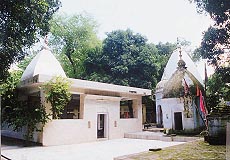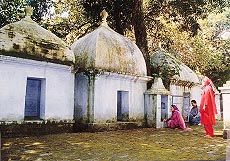By Kuldip Dhiman
"THIS is the only temple in India which is dedicated to the great teacher Dronacharya," the priest of the Drona Shiva Temple, Shiv Baadi, declares emphatically. As you stroll through the woods, your mind begins to wander. Is this the home of the legendary Dronacharya?
Was this forest house his famous gurukula? Is this the spot where the great teacher trained Arjuna and the rest? Believers accept the priest's words without much ado; skeptics ask for evidence: Alas! there is none.
The legend says that Yayati, Guru Dronacharya's little daughter, was intrigued by the daily disappearance of her father. He would go into the forest and return after a few hours. When she could no longer hold her curiosity, she asked her father about his long absence. All of her questions were met with vague, evasive answers, but the little girl was adamant. She wanted to know the truth.
 "I want to go with you, today", she said one day, blocking his way.
"I want to go with you, today", she said one day, blocking his way.
"No, my child' you are a little girl. I will take you along when you are a bit older."
But Yayati would not listen and in the end Dronacharya had to give in.
"My dear, your curiosity is understandable. I bathe in the Swaan river every day and then I proceed to the Himalayas, the abode of Lord Shiva. One must have the Lord's blessing and spiritual powers to undertake such a pilgrimage."
"Then, please teach me. You are after all the greatest teacher in the world."
Dronacharya held the little girl in his arms and asked her to recite Om Namo Shivaya. Yayati took her father's words seriously and began to chant the mantra everyday. Soon Shiva appeared, and on seeing that a little girl was chanting his name, he transformed himself into a little boy, and began to play with her. Yayati was very happy for having found such a lovable playmate.
One day, Dronacharya asked his daughter what she did in his absence. She told him about the little boy. Dronacharya was happy that at last his lonely daughter had found a companion to play with. A few days later, on his way to the Himalayas, Dronacharya realised that he had left something behind by mistake. When he returned home he saw his daughter playing with a little boy. It did not take long for Dronacharya to realise who the boy was. The great teacher bowed in reverence, and Shiva had to reveal his identity. Yayati could hardly believe her eyes. Shiva was extremely pleased with her devotion. He blessed her and said that her little village would be one of his favourite places.
Later Dronacharya installed a Shiva-linga on that very spot, and renamed the place Shiv Baadi. Although the present priest believes that 'the Shiva-linga we see today in the sanctum of the main temple is the same that Guru Dronacharya installed about 5,000 years ago', he has no historical evidence to support the claim.
Whether Guru Dronacharya lived here or not, the Drona Shiva Temple does look like an ancient gurukula. Perched on the top of a small hillock, and surrounded by a clump of dense trees, the temple transports you to another age.
 But apart from its association with Dronacharya, the temple has nothing much to offer — in terms of its architectural design or aesthetic beauty. However, two rows of samadhis (graves) on the far side of the temple's courtyard look interesting. They are dedicated to sages Ganga-giri, Ichcha-giri, Tamesh-wargiri, Somagiri, Harigiri and many others. The priests tells us that 'these saints meditated here for years, and later buried themselves in the ground below and left this world. These samadhis are dedicated to them'. We see no inscriptions or dates on these graves, but they certainly look quite old. Behind the graves, you can see many. Shivalingas and other idols that were installed by various saints and followers. Just a few places away, is the cremation ground — a Shiva temple always has a place for cremation next to it, we are informed by the priest.
But apart from its association with Dronacharya, the temple has nothing much to offer — in terms of its architectural design or aesthetic beauty. However, two rows of samadhis (graves) on the far side of the temple's courtyard look interesting. They are dedicated to sages Ganga-giri, Ichcha-giri, Tamesh-wargiri, Somagiri, Harigiri and many others. The priests tells us that 'these saints meditated here for years, and later buried themselves in the ground below and left this world. These samadhis are dedicated to them'. We see no inscriptions or dates on these graves, but they certainly look quite old. Behind the graves, you can see many. Shivalingas and other idols that were installed by various saints and followers. Just a few places away, is the cremation ground — a Shiva temple always has a place for cremation next to it, we are informed by the priest.
In sharp contrast to the aesthetically laid out samadhis, the main temple is admittedly an eyesore. It has no artistic, aesthetic, or architectural value worth mentioning. It is one of those plain white temple structures that have mushroomed all over the North. The practice of inscribing the names of donors on marble slabs deserves to be condemned because it adds 'visual pollution' It is graffiti of the worst kind. Can you imagine such ugly slabs on the walls and pillars of the Mahabalipuram Temple, or the Konark Sun Temple. To the right of the main temple, is another unadorned temple, constructed by Saint Baldevgiri about 70 years ago.
However, devotees, who pay little attention to aesthetic features, flock to Shiv Baadi in hundreds. Shivaratri is celebrated with great fervour. Another important occasion is the grand fair that is held on the second Saturday after Baisakhi. Located in Ambota village in Himachal Pradesh, Shiva Baadi is about 4 km from Gagret, if you are approaching from Hoshiarpur, and about 2 km from Mubarikpur, if you take the Chandigarh-Ropar-Nangal-Una road. Shiva Baadi can boast of one hotel that offers fairly good accommodation. To get more out of your trip, you could make Chintpurni your main destination, and spend a couple of hours at Shiv Baadi on your way back.http://www.tribuneindia.com/1998/98dec19/saturday/head8.htm
1 comment:
Dear Bro,
You are always diffrent from the crowd. Keep in touch.
Cheers,
Ashok Bali
Post a Comment